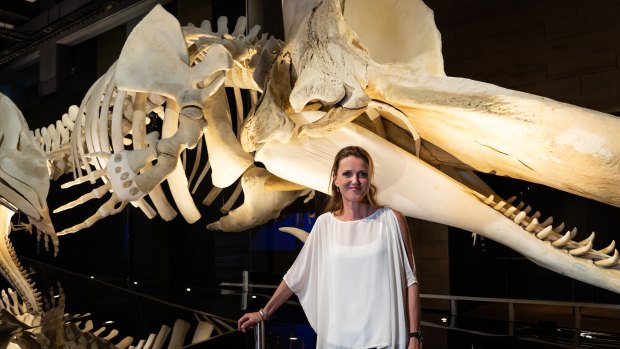By Keeli Cambourne
Fran Dorey gets to work with bones, bodies and scientific discoveries on a daily basis, but she’s not a surgeon like she imagined when she was in high school.
She’s also uncovering clues, putting pieces of forensic puzzles together and gathering evidence but it’s not as a detective, which was her other dream job as a teenager.
Instead, Dorey is lucky to combine her passions for science, communication and creativity in her career as a project manager, author and educator at the Australian Museum in Sydney.

Fran Dorey works at the Australian Museum in Sydney.
For the past 20 years, Dorey has worked with some of the world’s top museums. Since joining the Australian Museum as a volunteer in 1996, she has worked as a project manager, text writer or content expert on major exhibitions and projects.
Her latest project Whales | Tohora was a collaboration with New Zealand and Maori communities across the Tasman to showcase research from the international scientific community. Whales |
Tohora explores the diversity, biology and adaptation of whales to life in our oceans and celebrates their role in South Pacific Islanders’ rich cultural history.
“There were so many things I wanted to do when I was younger. I started a psychology degree but hated it and dropped out,” Dorey says. “I decided to do something I was passionate about and completed a bachelor of arts (honours) majoring in archaeology and loved it. In my free time I volunteered at museums, working with visitors in exhibitions and realised this is where I wanted to work.”
It was through her volunteering that Dorey was offered a job helping to write the interpretations of exhibitions for the public.
“It’s about communicating science and trying to explain difficult concepts and make science accessible to the public,” she says.
As well as her background in archaeology, Dorey added to her qualifications with a graduate diploma in education, and certificates in project management.
“There are two sides to the job I do. I lead a team doing the curation and content of an exhibition, deciding what it is that people are interested in and how best to tell it and then breaching the science and communication gap,” she says.
“Understanding the different ways people learn is a big part of an exhibition. You can’t do the same things all the time; you have to incorporate elements of touch, sight, interactivity, feelings and
reading.
“As well as the creative side there is the project-management aspect, including risk assessment, schedules, budgets and project plans, so you need to be hyper-organised.”
Dorey says for the Whales | Tohora exhibition the Australian Museum wanted to add some of its own content and offer visitors something different to the exhibits already on display.
“We brought out a lot of different whale material from the museum collections. We also created a digital trail through an app that takes visitors around the exhibits, which includes interactive games for children,” she says.
The app even has an augmented reality section so visitors can experience the whales swimming.
"You can never stop learning in a job like this. From new discoveries to changing technology, the scope of what museums can offer keeps growing. Studying archaeology and education gave me the perfect grounding as both fields have so many applications to what I do."
Andrew Costello, a senior archaeologist for Jacobs Engineering Group and president of the Australian Association of Consulting Archaeologists says there is a growing need for archaeologists in Australia.
“Archaeologists are needed in the private sector. There are lots of positions for archaeologists within in-house teams at engineering firms, mining companies and environmental consultancies,” he says.
“And the growing area is translating archaeological outcomes into the fabric of design – Aboriginal or historical motifs at railway stations, in highway sculptures or signage on walkways.”
Costello says Australian archaeologists are now most likely to be employed in the cultural heritage management sector, a big change from the past decade where there were more jobs in the museum and academic space.
“The main split is between archaeologists who work in historical archaeology and those who work in Indigenous or Aboriginal archaeology,” he says.
“Australia has one of the fastest rates of population growth of any developed country, with increasing industrialisation of urban and rural land, resulting in major impacts upon remaining archaeological and heritage places.
“This growth drives the demand for cultural heritage managers and archaeologists. Developers and state agencies responsible for the design and construction of transport and infrastructure are the main employers of commercial, or consulting archaeologists.”
As a consultant archaeologist, Costello says a large part of his job is negotiating the preservation or loss of heritage values and the impact it has on the archaeological record.
“Heritage, for all its connection to a fixed past, is alive and dynamic and mutable; its significance changes with the times and from person to person, community to community,” he says.
“Where Aboriginal heritage is concerned, consulting archaeologists help to record the values and significance to the community and - where possible - avoid, mitigate and offset the impacts through investigation and collaboration.”
As well as an archaeology degree, Costello says archaeologists with communication and problem-solving skills are in high demand.
“A big part of what archaeologists do is report writing, research and analysis as well as negotiating with multiple stakeholders who are often aiming for different outcomes,” he says.